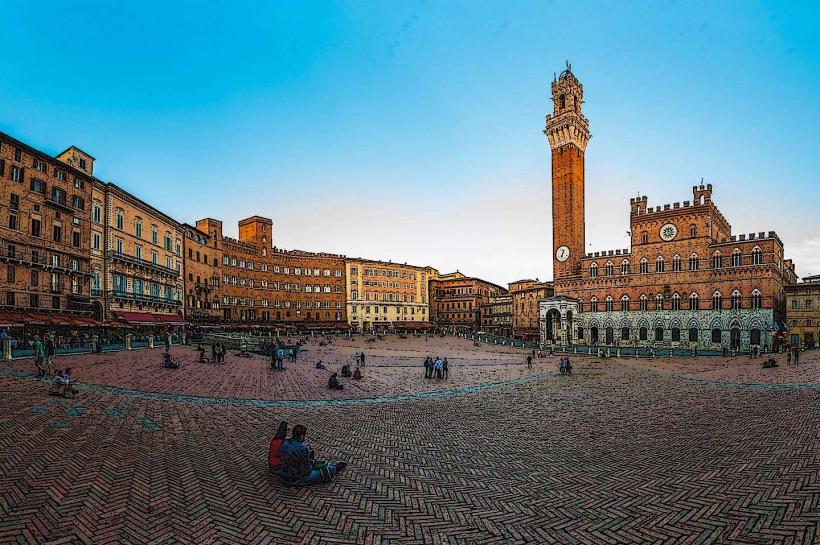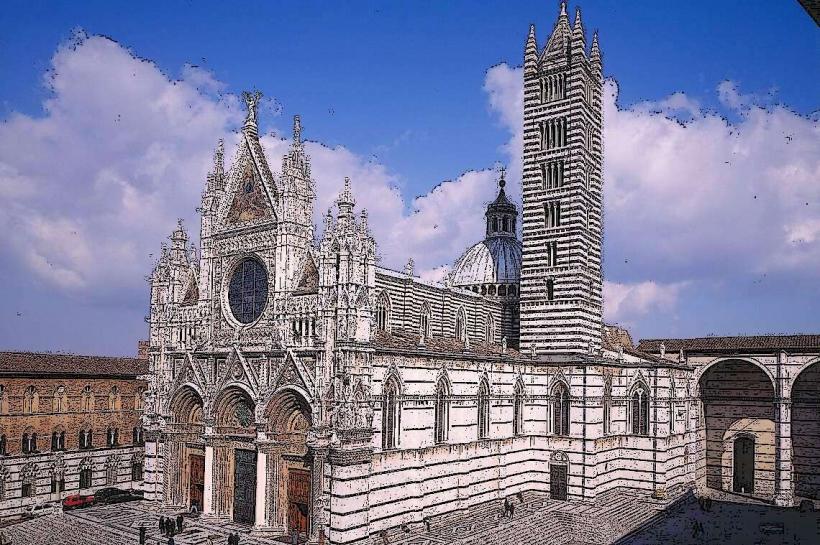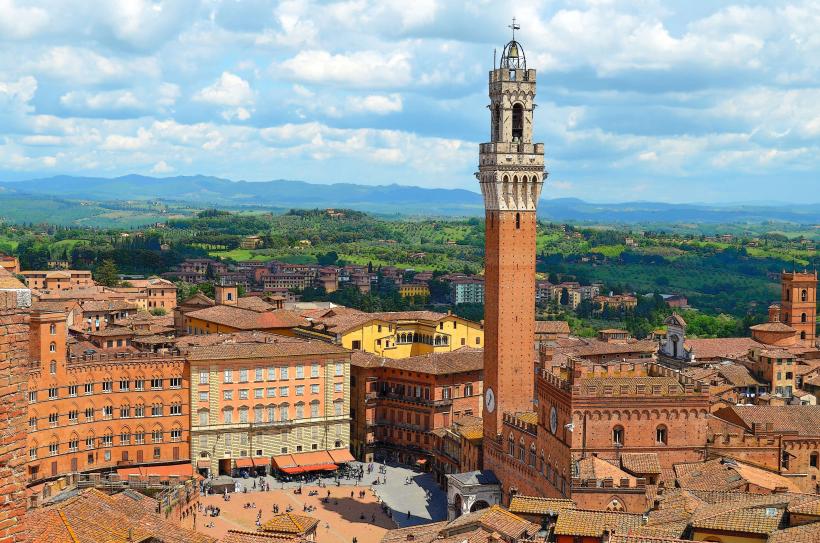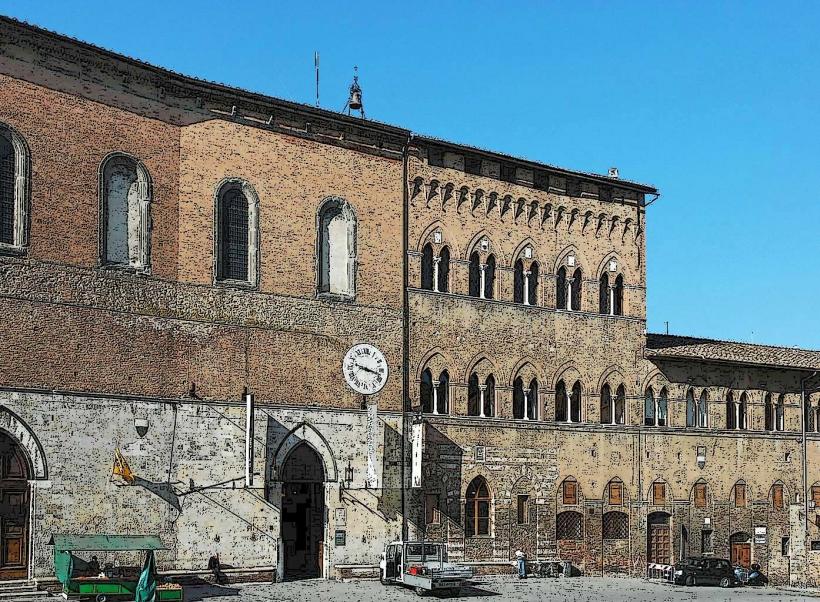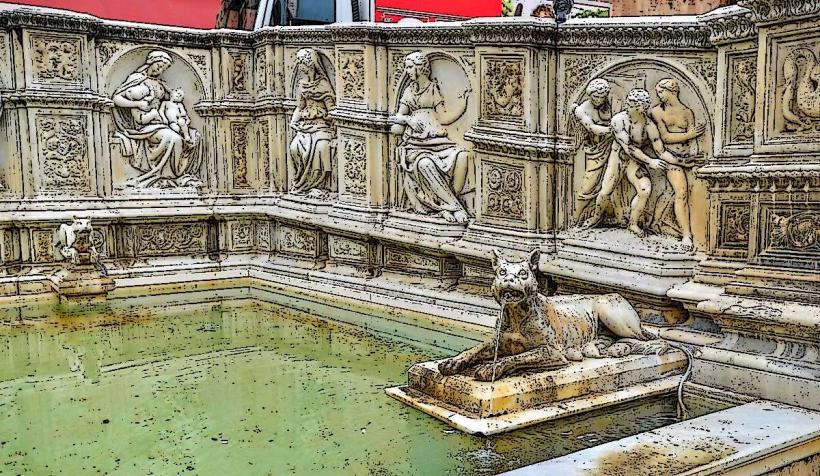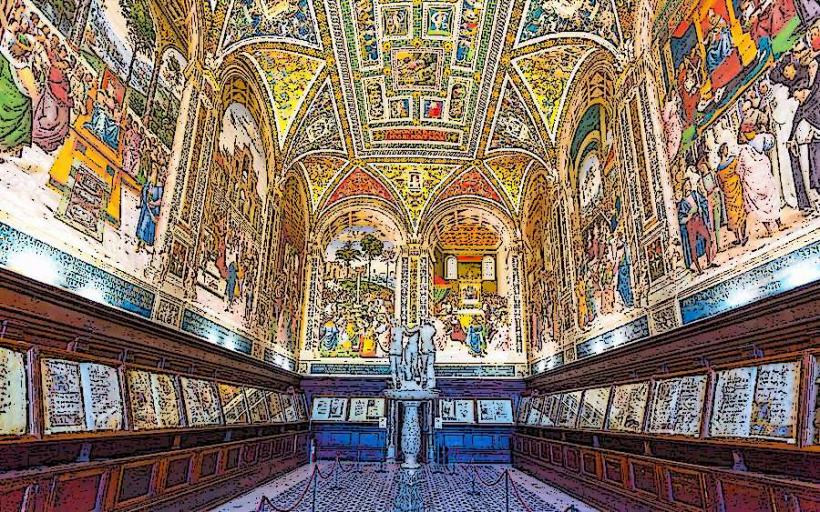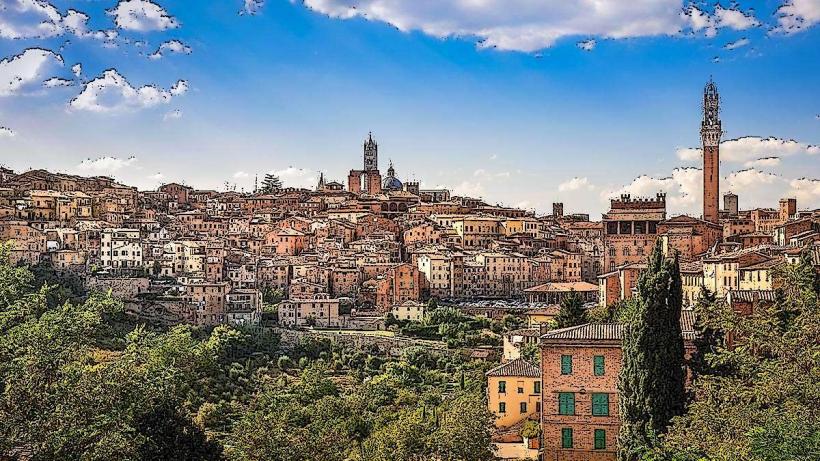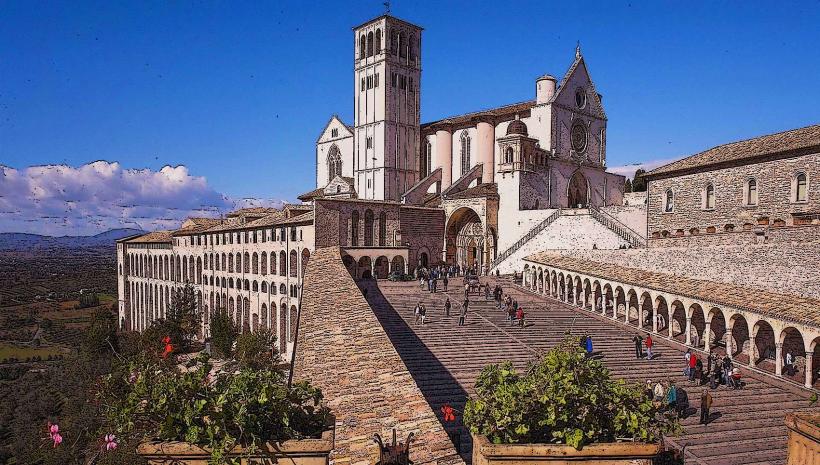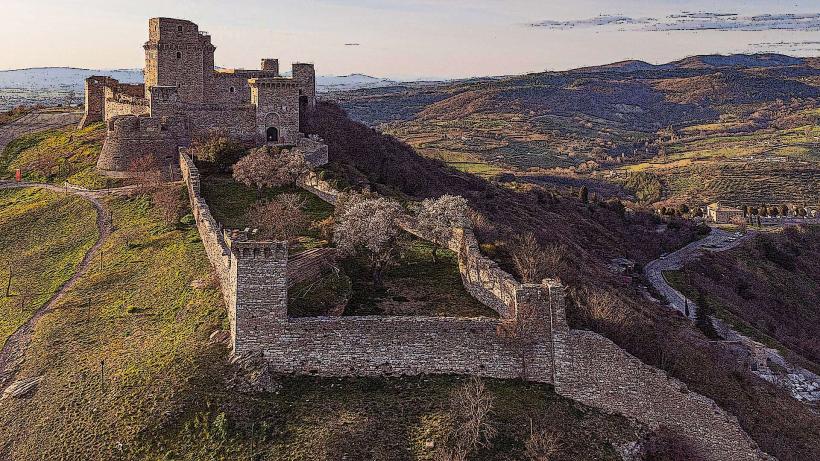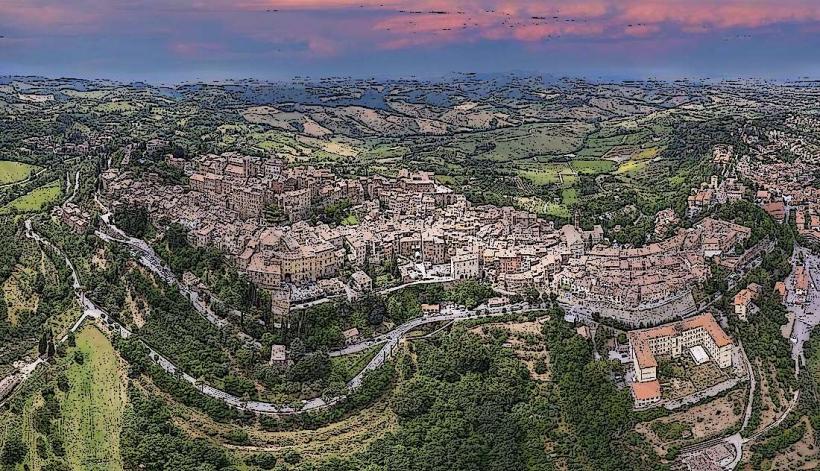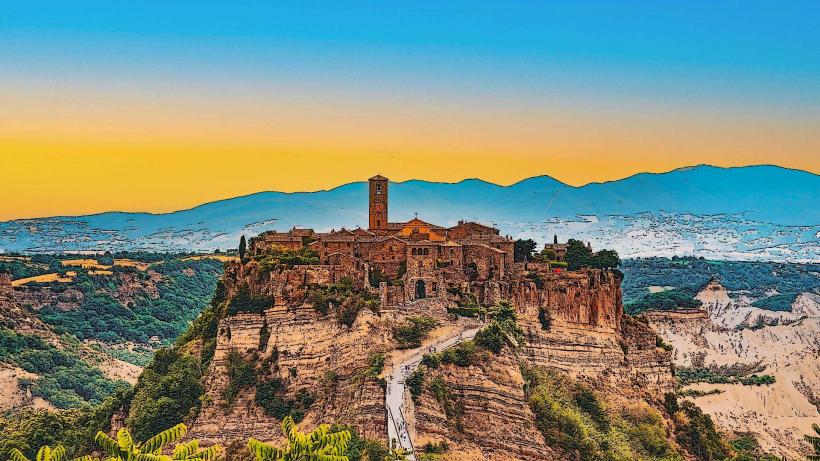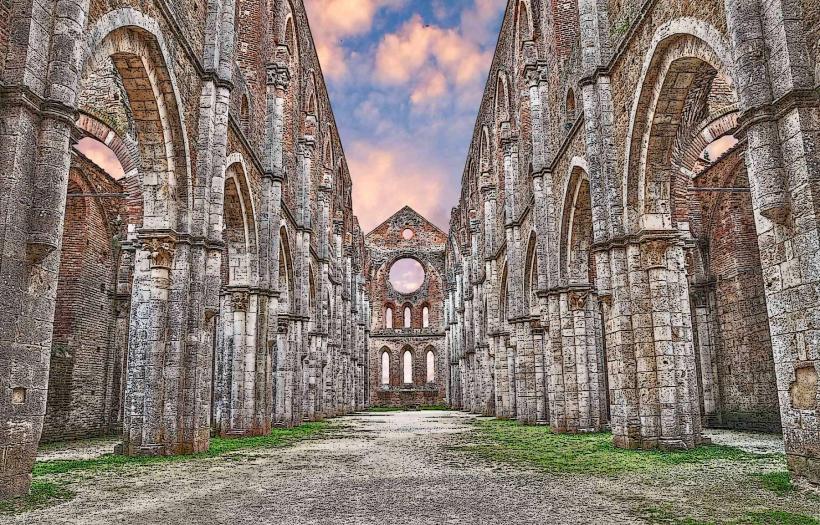Information
Landmark: Palazzo PubblicoCity: Siena
Country: Italy
Continent: Europe
Palazzo Pubblico is Siena's historic town hall, an architectural masterpiece located in the heart of the city in Piazza del Campo. Constructed between 1297 and 1310, it served as the seat of the city's government, symbolizing Siena’s civic pride and medieval political power. The building is an excellent example of Italian Gothic architecture and has been central to Sienese life for centuries.
Adjacent to the Palazzo Pubblico is the Civic Museum (Museo Civico), which occupies the upper floors of the building and is home to an extraordinary collection of medieval and Renaissance art. Together, the Palazzo Pubblico and the Civic Museum offer a glimpse into the history, culture, and governance of Siena during its most powerful years.
1. Palazzo Pubblico: Architecture and Design
Gothic Facade: The Palazzo Pubblico’s Gothic facade is a masterpiece of medieval architecture. The structure is primarily built from brick, with a series of large windows and pointed arches. The ornate design of the exterior reflects Siena’s wealth and civic identity during the late Middle Ages.
The Torre del Mangia: Attached to the Palazzo Pubblico is the Torre del Mangia, a tall and slender bell tower that reaches 102 meters (334 feet) in height. The tower was built as a symbol of Siena’s political independence and is an integral part of the building’s design. Visitors can climb to the top of the tower for panoramic views of Siena and the surrounding Tuscan countryside.
The Loggia: On the exterior of the building is the Loggia, an open arcade that offers a view of Piazza del Campo. The loggia was originally used for public speeches and announcements, linking the town hall directly to the life of the square.
2. The Civic Museum (Museo Civico)
Location and History: The Museo Civico occupies the upper floors of the Palazzo Pubblico and showcases the city’s rich artistic heritage. The museum was established in the 19th century and houses a significant collection of paintings, sculptures, and frescoes that reflect Siena’s artistic and political history, particularly during the Gothic and Renaissance periods.
Main Works of Art:
Maestà by Duccio di Buoninsegna: One of the most important artworks in the Civic Museum is the Maestà, the altarpiece by Duccio di Buoninsegna, one of the most significant painters of the Italian Gothic period. Originally part of the cathedral’s high altar, the Maestà is a monumental work depicting the Virgin Mary surrounded by saints, angels, and scenes from the life of Christ.
Frescoes by Simone Martini: The museum is home to significant works by Simone Martini, one of Siena’s most famous artists. His frescoes include the "Annunciation", one of the finest examples of Gothic art, which is part of the collection. Martini’s work combines religious themes with elegant figures, vibrant color, and an exquisite sense of grace.
The Allegory of Good and Bad Government: One of the museum’s most important fresco cycles is “The Allegory of Good and Bad Government” by Ambrogio Lorenzetti. Painted between 1338 and 1340, this fresco is located in the Sala dei Nove (Hall of Nine) and vividly depicts the consequences of just and unjust rule. The fresco is divided into two sections: one illustrating the effects of good government (peace, prosperity, and harmony) and the other showing the chaos, corruption, and decay brought about by bad government. It is a profound political commentary on governance and the role of civic virtue.
The Hall of the Mappamondo: This room features a large medieval world map (mappamondo), which reflects Siena’s understanding of the world at the time. The map is a remarkable example of medieval cartography and offers insight into Siena’s place in the broader medieval world.
3. Function and Symbolism of the Palazzo Pubblico
Political Hub: The Palazzo Pubblico was not only a place for art but also served as the seat of Siena’s Republican government. The building housed the Council of Nine, the governing body of the city during much of the Middle Ages. The Hall of the Nine (Sala dei Nove) was used for meetings and decisions of the council, making the building a central site of civic power.
Symbol of Siena’s Identity: The Palazzo Pubblico and its artworks, especially the frescoes by Lorenzetti, reflect Siena’s civic values and pride. The city’s emphasis on justice, good governance, and the connection between politics and religion is evident throughout the building. The frescoes also symbolize the fragility of good governance, with the contrasting depictions of peace and chaos illustrating the risks of political corruption and the benefits of virtuous leadership.
The Civic Museum’s Role: The museum preserves and presents Siena’s artistic and cultural legacy, much of which was created to honor the city’s political and religious importance during the Middle Ages and the Renaissance. The Civic Museum helps visitors understand how art and politics were intertwined in Siena’s history, and how the city’s governance was represented through its artistic expression.
4. Visiting the Palazzo Pubblico and Civic Museum
Visitors to the Palazzo Pubblico can explore its architectural beauty, climb the Torre del Mangia for panoramic views, and admire the museum’s art collection. The museum offers a fascinating journey through Siena’s history, showcasing its civic pride, its role in the medieval world, and its influence on the art of the time.
The Civic Museum also offers temporary exhibitions, educational programs, and events, making it an active cultural center that continues to celebrate and share Siena’s rich heritage.
5. UNESCO World Heritage Status
- Along with the entire historic center of Siena, the Palazzo Pubblico and its Civic Museum are part of a UNESCO World Heritage Site. This recognition highlights the importance of the building as a center of medieval political life and its integral role in preserving Siena’s cultural and artistic legacy.
Conclusion
The Palazzo Pubblico and Civic Museum are cornerstones of Siena’s artistic, political, and architectural heritage. Together, they provide a window into the city’s medieval and Renaissance past, with masterpieces by Duccio di Buoninsegna, Simone Martini, and Ambrogio Lorenzetti, among others. The Palazzo Pubblico is not only a magnificent building but also a powerful symbol of Siena’s civic identity and its historical role as an independent republic.

